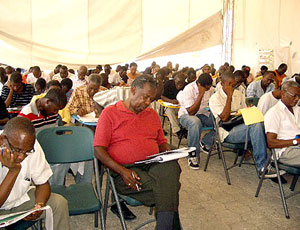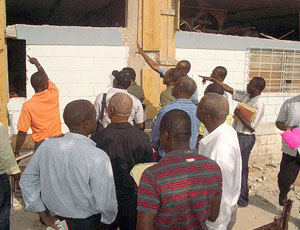

Some 200 Haitian engineers and engineering students gathered in Port-au-Prince on May 20-22 under a tent in plus-90°F heat to learn about seismic-resistant design and construction. The four introductory courses—which covered topics such as the seismology and seismicity of Haiti, earthquake-resistant design principles and rapid building assessment methodology—were held thanks to an agreement between the University of Quisqueya (UniQ) in Port-au-Prince and the University at Buffalo’s Multidisciplinary Center for Earthquake Engineering Research (UB-MCEER).
The goal of the memorandum of understanding between UniQ and UB-MCEER is to promote academic exchange and cooperation regarding quake-resistant design and construction for the next three years. UB-MCEER planners were advised by their counterparts in Haiti to charge a nominal fee ($80) for the initial program to overcome potential cultural perceptions that a free program might be lacking in value. Otherwise, MCEER is underwriting the first series, named the First Earthquake Engineering Seminar. Plans call for developing longer-term programs on the seismic design of buildings, with a focus on adapted techniques for reconstruction. While UB-MCEER plans to seek additional funding sources for future programs, “the urgent need in Haiti prompted the planners to focus on getting the educational programs started as soon as possible,” says Ellen Goldbaum, a spokeswoman for MCEER.
The first four courses in the seminar were taught by either Andre Filiatrault, a UB earthquake engineer, or Haiti native Pierre Fouche, a doctoral student in earthquake engineering at UB. The courses were developed, in French, with an understanding of current Haitian construction practices. The aim is to help Haitian engineers gain knowledge of fundamental earthquake engineering principles for retrofit of damaged facilities and design of new construction. Seminar participants also learned how to conduct rapid building assessments using the U.S. standard, the Applied Technology Council’s ATC-20 Procedures for Postearthquake Safety Evaluation of Buildings.


Post a comment to this article
Report Abusive Comment